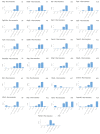The Cuprizone Model: Dos and Do Nots
- PMID: 32244377
- PMCID: PMC7226799
- DOI: 10.3390/cells9040843
The Cuprizone Model: Dos and Do Nots
Abstract
Multiple sclerosis (MS) is a chronic inflammatory demyelinating disease of the central nervous system. Various pre-clinical models with different specific features of the disease are available to study MS pathogenesis and to develop new therapeutic options. During the last decade, the model of toxic demyelination induced by cuprizone has become more and more popular, and it has contributed substantially to our understanding of distinct yet important aspects of the MS pathology. Here, we aim to provide a practical guide on how to use the cuprizone model and which pitfalls should be avoided.
Keywords: cuprizone model; histological analyses; multiple sclerosis.
Conflict of interest statement
The authors declare no conflict of interest.
Figures







Similar articles
-
TRPA1 deficiency is protective in cuprizone-induced demyelination-A new target against oligodendrocyte apoptosis.Glia. 2016 Dec;64(12):2166-2180. doi: 10.1002/glia.23051. Epub 2016 Aug 29. Glia. 2016. PMID: 27568827
-
Ursolic acid treatment suppresses cuprizone-induced demyelination and motor dysfunction via upregulation of IGF-1.J Pharmacol Sci. 2020 Nov;144(3):119-122. doi: 10.1016/j.jphs.2020.08.002. Epub 2020 Aug 19. J Pharmacol Sci. 2020. PMID: 32921392
-
Motor Behavioral Deficits in the Cuprizone Model: Validity of the Rotarod Test Paradigm.Int J Mol Sci. 2022 Sep 26;23(19):11342. doi: 10.3390/ijms231911342. Int J Mol Sci. 2022. PMID: 36232643 Free PMC article. Review.
-
Prostaglandin F2α FP receptor inhibitor reduces demyelination and motor dysfunction in a cuprizone-induced multiple sclerosis mouse model.Prostaglandins Leukot Essent Fatty Acids. 2014 Nov;91(5):175-82. doi: 10.1016/j.plefa.2014.08.004. Epub 2014 Sep 6. Prostaglandins Leukot Essent Fatty Acids. 2014. PMID: 25224839
-
The cuprizone animal model: new insights into an old story.Acta Neuropathol. 2009 Dec;118(6):723-36. doi: 10.1007/s00401-009-0591-3. Epub 2009 Sep 18. Acta Neuropathol. 2009. PMID: 19763593 Review.
Cited by
-
The neuroprotective potential of mesenchymal stem cells from bone marrow and human exfoliated deciduous teeth in a murine model of demyelination.PLoS One. 2023 Nov 9;18(11):e0293908. doi: 10.1371/journal.pone.0293908. eCollection 2023. PLoS One. 2023. PMID: 37943848 Free PMC article. Clinical Trial.
-
The Extracellular Matrix Proteins Tenascin-C and Tenascin-R Retard Oligodendrocyte Precursor Maturation and Myelin Regeneration in a Cuprizone-Induced Long-Term Demyelination Animal Model.Cells. 2022 May 28;11(11):1773. doi: 10.3390/cells11111773. Cells. 2022. PMID: 35681468 Free PMC article.
-
GCN2-Mediated eIF2α Phosphorylation Is Required for Central Nervous System Remyelination.Int J Mol Sci. 2025 Feb 14;26(4):1626. doi: 10.3390/ijms26041626. Int J Mol Sci. 2025. PMID: 40004088 Free PMC article.
-
Quantitative Analysis of Early White Matter Damage in Cuprizone Mouse Model of Demyelination Using 7.0 T MRI Multiparametric Approach.ASN Neuro. 2024;16(1):2404366. doi: 10.1080/17590914.2024.2404366. Epub 2024 Oct 14. ASN Neuro. 2024. PMID: 39400556 Free PMC article.
-
Neuron-Oligodendrocyte Interactions in the Structure and Integrity of Axons.Front Cell Dev Biol. 2021 Mar 8;9:653101. doi: 10.3389/fcell.2021.653101. eCollection 2021. Front Cell Dev Biol. 2021. PMID: 33763430 Free PMC article. Review.
References
Publication types
MeSH terms
Substances
LinkOut - more resources
Full Text Sources
Other Literature Sources
Medical

